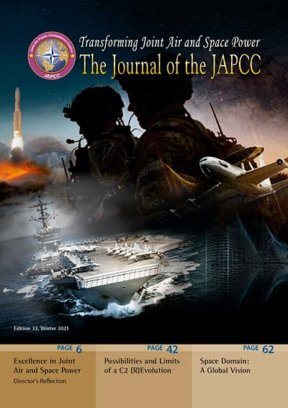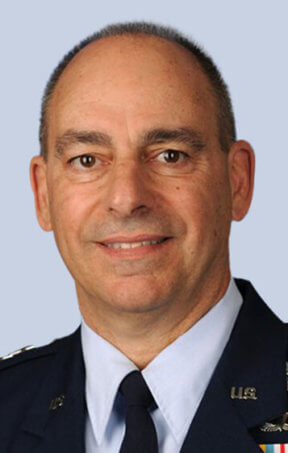The last three years presented a dynamic and challenging strategic environment to the North Atlantic Treaty Organization, its Allies and partners across the globe. Looking back to where we started this journey in 2019, we have significantly shifted into an era of fierce strategic global competition where our competitors challenge our norms, test our commitment to our Allies and the international rules-based order, and expose us to rapidly advancing threats and technology.
Throughout these challenges, our collective Air and Space Power team, comprised of the Joint Air Power Competence Centre (JAPCC), Allied Air Command (AIRCOM), and the Nations’ Air and Space Forces, have consistently delivered effects for the Alliance: 24/7 Air Policing and Ballistic Missile Defence Mission; adopting and operationalizing the Deterrence and Defence of the Euro-Atlantic Area concept; and championing a collective approach to change and shape the future. These enormous and essential tasks continue to move forward due to the dedication, perseverance, and ingenuity of our amazing people.
The Alliance demonstrated a shift in strategic focus during 2019. In response to acknowledging Russia as a strategic competitor with activities across all domains, NATO implemented a series of work strands that focused on reinforcing the commitment to collective defence and modernizing our approach to the adversary. A seminal NATO Military Strategy set the groundwork for maintaining a credible and effective deterrence and defence. Core to success in these areas is a simplified Command and Control (C2) structure – executable, repeatable, and understood. Subject matter experts from AIRCOM and the JAPCC supported the creation of a Joint C2 Concept of Operations and crafted an Air C2 Concept of Operations that provides flexibility, adaptability, and resilient control with a theatre-wide approach utilizing supported and supporting relationships. Proven in multiple joint exercises since 2019, this construct continues to be the template for component C2 across the Alliance.
NATO continued to adapt by recognizing the need to officially declare Space as an operational domain in December of 2019. Approximately ten months later, in October of 2020, the NATO Space Centre was created to support NATO activities and operations, increase NATO Space Domain awareness, and help protect Allied Space systems by sharing information. Coordination with nations in the Space domain is a critical mission as civilian, military, and commercial organizations increasingly depend on Space capabilities for our safety and security. Space domain barriers to entry continue to diminish. Commercial companies such as Boeing, SpaceX, Virgin Galactic, and Blue Origin provide low-cost logistical support for nations, industry (banking, agriculture, communications), and even leisure travel. Based on this growth, we must prepare for fierce competition in Space.
Consequently, NATO is committed to ensuring free and open access to the Space commons, focusing on increased Alliance Space domain awareness, promoting adherence to internationally recognized norms, and deterring actions that would lead to militarization of Space. Additionally, the advent of commercial leisure travel in Space brings a literal new dimension to protection and security of the extraterrestrial and beyond. To support the Space domain, NATO approved a new Space Centre of Excellence, based in Toulouse, France. During the stand-up and transition period, the JAPCC will continue to provide space-related articles, research, and advice and looks forward to supporting the new Space Centre of Excellence in the future.
Outside of the advent of the Space domain, the year 2020 brought its unique set of challenges. A pandemic gripped the world in early 2020. The COVID-19 virus exploded across the globe, hindering the world economy, altering personal and professional interactions, and testing the strength and fabric of the NATO Alliance. However, even with these uncertain pressures, Air Policing activities remained stalwart and consistent, executing a record number of air intercepts in 2020. With the activation of Rapid Air Mobility processes, Airmen facilitated short notice movements of medical supplies throughout their Area of Responsibility (AOR). Innovative operations enabled continued progress on essential projects, large-scale training and exercises, and continued readiness of the multinational force. In fact, the Alliance’s human element – its people, its backbone – adapted and overcame the struggles with perseverance and innovative thinking ensuring the health crisis did not turn into a security crisis while continuing to deliver 24/7 Air and Space Power to the Alliance.
The concept for Deterrence and Defence of the Euro-Atlantic Area (DDA) shifted focus to address a 360-degree threat across the entirety of the Supreme Allied Commander Europe (SACEUR) AOR. The refined C2 structures execute supported and supporting relationships that rely on high levels of trust and confidence between commanders, in order to provide effects with constrained resources. We drew support from across the Alliance, nurtured relationships with partners, and solidified the all-domain connective tissue through exercises such as Steadfast Jupiter and Ramstein Ambition.
Furthermore, effective deterrence requires coherent national input. In an effort to align national activities, the air component increased collaboration with the maritime component to create repeatable, operational training opportunities that span multiple domains (AIRCOM/MARCOM playbooks). These events test the connective tissues of joint C2, strengthens national and Alliance relationships, and builds a more refined and competent deterrence force. Similarly, we continued to educate the collective Air and Space community with publications and reviews such as the ‘A Comprehensive Approach to Countering Unmanned Aircraft Systems’ book and the JAPCC Journals, to study topics such as Joint All-Domain Operations and to connect via the in-person JAPCC Conference, the NATO Air Chiefs Symposium, and the Partner Air Chiefs Conference. These efforts consistently brought together Air and Space leaders to build relationships and strengthen the collective commitment to maintaining peace and stability.
Throughout 2021, we continued to develop and integrate new Air and Space capabilities. The 5th generation aircraft are integrating into numerous NATO Allied Air Forces’ inventories and drive nations to normalize tactics, techniques, and procedures for 4th and 5th generation aircraft integration. These aircraft are essential to the deterrence and defence of the Euro-Atlantic Area and nations have executed Air Policing in the North Atlantic, Baltic, and Mediterranean areas. Moreover, 5th generation subject matter experts have been incorporated in HQ AIRCOM Joint Force Air Component staff, providing knowledge and experience essential to our planning and daily operations.
As an Alliance, we must leverage the technological capabilities provided by these stealth aircraft to increase connectivity and our situational awareness throughout SACEUR’s Area of Operations through multinational training such as Atlantic Trident and Falcon Strike. We must also recognize that a single platform by itself cannot meet the full potential of its capabilities, but instead must contribute to a system of systems that connects our Allies and partners through a shared common operational picture. Our most effective force will only be realized with national input and enhanced communications sharing.
In late summer of 2021, the world witnessed the end of a decades-long war in Afghanistan. In a massive, short-notice airlift operation, the power and capability of air mobility was demonstrated on a world stage. In conjunction with multinational efforts, NATO’s Operation Allied Solace accomplished what is likely the most significant airlift operation of the 21st century. The success was only accomplished through the close cooperation and integration of our allies and partners across the globe. Our aircrews demonstrated that flexibility is the key to Air Power and, even in a stressful and discordant environment, underlined the commitment, determination, and courage of NATO’s men and women. This event reaffirmed the Alliance’s commitment to our shared values, considering the human side of conflict and providing dedicated military and civilian support to the families airlifted to safety. As we all know, we are stronger together and I am extremely proud of the efforts of our team.
The Alliance continued to further align its focus with a near-term operational perspective in SACEUR’s AOR Wide Strategic Plan and a long-term perspective of how to think, act, organize, and adapt in the NATO Warfighting Capstone Concept. This alignment is necessary to address technology advances that can threaten large population centres and put the security of Alliance members at risk. The use of grey zone tactics to blur the lines between outright acts of aggression and peaceful competition demands innovative solutions. Therefore, we must embrace change, remain aligned with our Allies and partners, and ensure the highest levels of force readiness to be able to win in deterring our adversaries.
Looking forward to 2022 and the future, the Air Component will continue to deliver joint effects while recognizing challenges, creating innovative solutions, and adapting to the shifting environment. These efforts will expand our competitive edge into the future and remain fundamental to sustained success. Effective C2 will rely on timely and accurate indications and warnings. Cutting-edge technologies such as cloud computing and artificial intelligence will be integral to Alliance intelligence, C2, and delegated authorities. To remain both strategically relevant and tactically efficient demands an ability to make decisions at speed. Joint All-Domain Operations and NATO’s Alliance Future Surveillance and Control require reliable information that is accessible to the right decision-makers at the right time, ultimately providing an undeniable advantage in information, awareness, and decision-making. The Air and Space domains recognize that open architecture systems which embed coders with warfighters enable software enhancements that meet and likewise challenge the adversary. We must lead the joint force in breaking free from our preconceived notions to be ready for the next conflict.
Reflecting on my time as Commander Allied Air Command, no matter how much the world has changed, I am encouraged to see that the Alliance remains strong, committed to its Allies, and prepared to deter and defend. I am very proud of the role the JAPCC played in fostering strategic thinking and providing the Alliance with extremely valuable Air and Space deliverables again and again. As the oldest and notably the highest producing Centre of Excellence, the JAPCC has and will continue to support the Air and Space Power community as it continues to meet the call of providing air and space power, at any time and any place and under any conditions. Lastly, I must note that the continued successes of NATO Allied Air Command are built upon the shoulders of our individual Airmen. The future of the Air and Space domains is in great hands …












